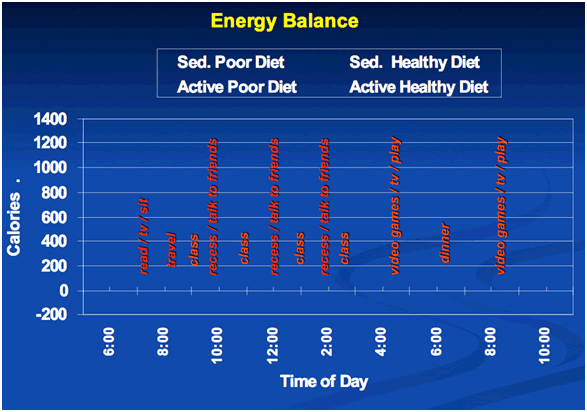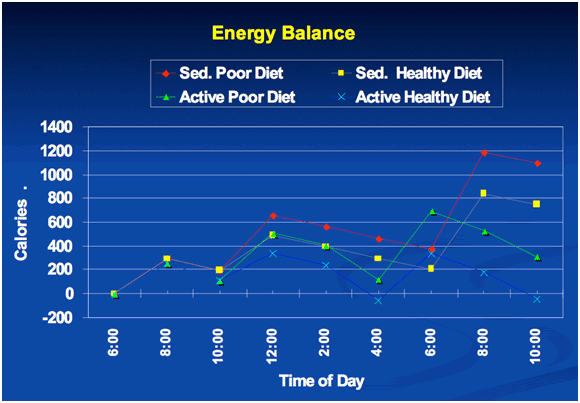|
SOLVING
THE OBESITY CRISIS PART II: A SIMPLE
PLAN  (download:
Word
'07, Word
'95-'03)
(download:
Word
'07, Word
'95-'03)
by Steve
Jefferies, publisher, pelinks4u
In January’s
pelinks4u, I shared some
issues that seemed to me to be most
important in addressing the obesity
crisis. They were mostly observations
about the challenges we face rather
than practical solutions. So, this month,
I’m sharing a perspective on how
we, as physical educators, could take
steps to address the key causes of obesity:
poor diet and insufficient physical
activity.
I should probably apologize at the
outset that the plan I propose is not
very sophisticated. In fact it’s
downright simple. But it puzzles me
that many of the interventions I currently
see being tried have no hope of being
successful. For example, recently in
one of our local schools a grant provided
small sacks of fresh vegetables to elementary
grade kids. The kids loved them. And
presumably it was a healthy alternative
to their typical diet. But then the
grant ended and with it the fresh vegetables.
Who knows how much this intervention
cost, but I doubt it changed the kids'
eating habits.
Around the country I read about the
introduction of special programs designed
to promote physical activity or improve
eating habits. Although well-intentioned,
I don’t see the point unless they’re
sustainable without grant support. It’s
a bit like sending someone - at no charge
- to a health spa for a couple of vacation
weeks. Instead of working and other
daily drudgery, they enjoy healthy dining
and free recreational physical activities.
In this new environment it’s pretty
easy to adopt a healthy lifestyle. But
this misses the point. If we can only
stay healthy when we have easy access
to spas, pools, gyms, parks, trails
and the like, we’ll never turn
back the obesity tide. To solve obesity
it’s much more important to think
creatively about what we can do in our
existing environments, not some inaccessible,
artificial, or temporary alternative.
As I noted in January, the focus has
to be on changing people’s lifestyle
behavioral patterns. Healthy people
don’t do anything special to stay
healthy. Their lifestyle is health promoting
because of their daily behavioral habits.
Where a choice is to be made they choose
the healthy option: not because it’s
healthy but because it’s their
preferred choice. So with this in mind
here’s a simple plan for solving
worsening obesity among students.
Each day consists of time during which
we are either consuming or burning calories.
In the case of kids, typical activities
during the school day are illustrated
in red in figure 1.
Figure
1: Children's Daily Activities

As you can see kids wake up, dress,
eat breakfast, get ready for school,
and then somehow get from the home to
school. Arriving at school they either
go to the classroom, or spend time on
the playground. Classes begin and continue
until morning recess (unless it’s
been eliminated), then return to classes
until noon recess. They now have time
both in the lunchroom and on the playground
before returning to class.
Mid-afternoon, school ends whereupon
kids travel home, remain for some
afterschool activity, or go to
a day care facility. By early
evening they’re back home,
eat dinner, and do some kind of
activity before bedtime. For most
students across the United States
- indeed the entire Western world
- this schedule varies little
for 12 or more years.
Looking at it another way, the day
of a K-12 student is an ebb and flow
of calorie consuming or calorie burning
activities. This is represented in figure
2. In this case, Dr.
Kirk Mathias, my colleague at Central
Washington University, reviewed typical
food choices and constructed sample
“healthy” and “poor”
(unhealthy) daily diets. He then examined
likely energy expending activities throughout
the day. Combining these two data sources,
he was able to create typical energy
balance graphs for both sedentary and
active students.
Several interesting observations emerged.
First, it appears that of the four groups
shown, only active students who eat
healthy diets burn more calories than
they consume. Every other group consumes
excess calories. Second, regardless
of whether sedentary students eat healthy
or unhealthy diets, they still consume
more calories than they burn –
hence the weight gain. Third, and perhaps
most importantly for physical educators,
any intervention throughout the school
day that increases student expenditure
of calories has the potential to change
the final outcome of any of these graph
lines.
So, for example, an intervention such
as adding an active form of transportation
to school (e.g. walking, bike riding,
walking school bus, etc.), can provide
some students with enough physical activity
to balance their caloric intake. Creating
more opportunities for playground play
prior to the start of school, starting
the school day with a short physical
activity, taking classroom physical
activity breaks during the day, adding
more physical education, improving school
lunches, ensuring that all children
take recess outside, switching the content
of vending machines, and eliminating
unhealthy classroom snacks are all relatively
easy to implement interventions to change
the energy balance situation. And the
addition of active after school physical
activities between the (on average)
3 hour end of the school day and evening
dinner could completely reverse the
trend toward excessive caloric consumption.
Figure 2: Energy Balance of Children on Healthy and Unhealthy Diets

And finally, three ways in which
this obesity reduction plan differs
from many current initiatives: (1) It
could be introduced relatively easily
into every school environment across
the United States; (2) It wouldn’t
require a huge funding investment to
become sustainable; and (3) It is focused
on creating permanent, habitual, health-promoting
lifestyle behaviors among today’s
youth.
Steve Jefferies, Publisher
pelinks4u
(pelinks4u
home) |



